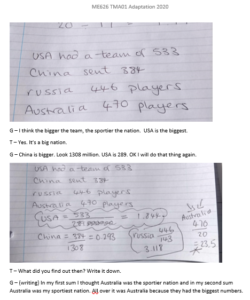There has been so much change over the past year, especially in educational settings. At the Open University we know about distance and remote learning – it’s been happening for over 50 years! But even those students who did not normally have in-person exams or tutorials were still impacted in some way by the lockdown. We wanted to give an update on some of the things we put in place to ensure students could continue their studies during the pandemic.
At the end of March last year, students were preparing to begin their studies for two of our maths education modules that start in April: ME625 Developing Algebraic Thinking and ME626 Developing Thinking in Statistics. A key part of these modules is to work with a learner, and this is the basis for three out of four of the assessments. Working with learners means students on these modules must plan tasks, analyse learners’ work, and reflect on what the next steps could be. Analysing learners’ work involves recognising mathematical thinking and using ideas and frameworks from the module to discuss the mathematical activity. These are considerations that students consider when studying mathematics education modules under normal circumstances. But then there was March 2020…
The learners that OU maths education students work with can be of any age, with any level of previous maths experience. They can be adult friends or family members or school-age learners that the student lives with or knows. Some of our maths education students work in schools themselves and will often work with learners at the school as part of their assignments. So, when schools closed to non-key-worker children, and social distancing measures were put in place, there was the potential for some students to be unable to successfully complete their assignments. When we realised this would be the case, we put our heads together (remotely) to come up with a solution that would afford students the opportunity to analyse and reflect on a learner’s work in an authentic setting, but without the need to interact with them face-to-face. There were two options for those students who could not work with a learner in their household bubble:
- Work remotely with a learner, via video conference or telephone
- Complete an alternative assignment that does not require the need to work with a learner.
Last year there was still a significant number of people who were not familiar with using video conferencing software, especially to teach and learn with! We created some supporting videos that demonstrated how students could work with a learner and, importantly, suggestions for viewing and saving learners’ work so that it can be annotated and analysed as part of the assignment. These included sharing a whiteboard, creating a homemade visualiser, annotating on a shared screen and options for working asynchronously (not ‘live’). These supporting videos are available within the ‘Resources’ area of the maths education modules.
The second option was a bit trickier. Where there was no possibility of working with a learner in person or remotely, we needed to provide an alternative assignment that could be marked using the same assessment criteria as the original, and that was equivalent in terms of difficulty. Across all the assignments that include working with a learner, a common element is writing a reflective account of the learners’ work. In doing so, students can demonstrate their ability to evaluate and reflect on the ways learners responded to a particular task, paying attention to module ideas and frameworks such as specialising and generalising, freedom and constraint and doing and undoing. This analysis is a key area of the assignments and is possible even where the student has not worked with learners directly, provided that the task and learner work is suitable.
We developed an alternative assignment that afforded students the opportunity for this rich discussion by creating plausible accounts of learners’ work. These accounts were based on our knowledge of likely student and learner interactions on a task, as summarised and analysed in previous assignments. In these accounts we compiled and created dialogue and mathematical working that was messy, contained errors, was sometimes aimless or boring but included evidence of mathematical thinking.
Of course, this alternative has some drawbacks; there is little choice of tasks for students, so there is less flexibility about which module frameworks to write about. We would always recommend working with a real learner where possible. Learner interaction provides the opportunity for a rich discussion about the key ideas from the modules. The authenticity of working with a real learner can prompt students to recognise mathematical thinking that might not exist in an artificial context. The act of choosing and adapting a task with these module frameworks in mind is also pertinent to the assignments; a task that does not allow for generalising, for example, would not be a good choice if the assignment needs to include a discussion of specialising and generalising – something we considered when creating the alternative assignments. Students are also asked to annotate their learners’ work to provide evidence to support the discussion, and so tasks need to allow for learners to produce some work, rather than be wholly verbal. Working with learners directly (either in person or remotely) is also good practice for those students who want to work in an educational setting.
In total, a handful of students in each module have made use of the alternative assignments. We are certainly glad we were able to provide an alternative for those students; it is the right thing to do to ensure all students have fair access and support for assignments, and it made us look back on past assignments and reflect again on the benefits of working with learners.

